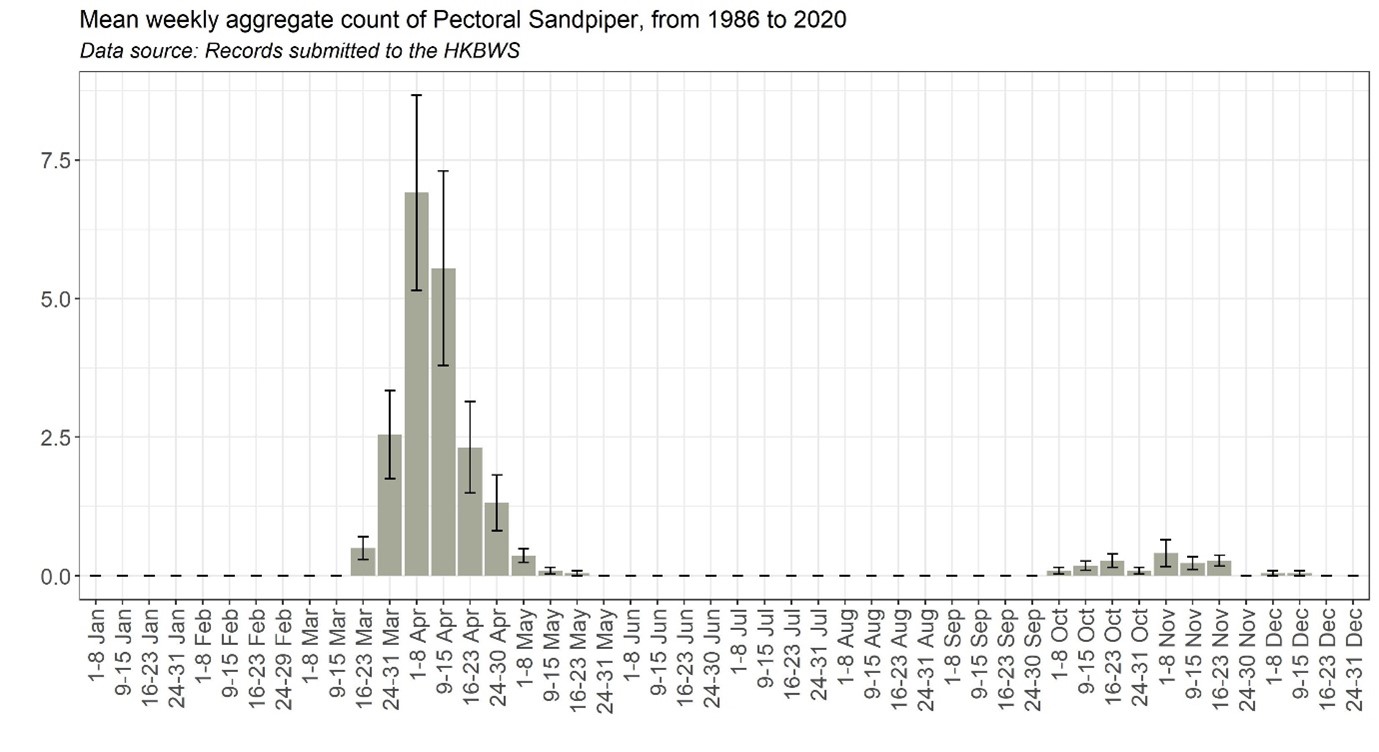PECTORAL SANDPIPER Calidris melanotos 斑胸濱鷸
Category I. Passage migrant to wetlands, rare in spring and very rare in autumn.
IDENTIFICATION

May 2015, Martin Hale. Adult female.
19-23 cm. Similar in size and general proportions to Sharp-tailed Sandpiper but always has a heavily streaked breast that is sharply divided from the white belly, a duller, poorly-marked supercilium showing less contrast with dull brown crown and slightly longer and heavier bill. Adult male in breeding plumage has coarsely mottled breast while on adult female (illustrated) it is neatly streaked. Adult males are noticeably larger than females.

May 2023, Paul Leader. Second calendar-year.
Although it is generally considered that first breeding plumage is indistinguishable from adult breeding plumage (Farmer et al. 2020), the dullness of this bird suggests it is in its second calendar year.
Juveniles have neatly fringed rufous upperpart feathers and usually obvious white scapular- and mantle-Vs.
VOCALISATIONS
The typical flight all away from the breeding grounds is a short churring ‘chrrrip’.
DISTRIBUTION & HABITAT PREFERENCE
Most records have occurred in the Deep Bay area, mainly on the intertidal mudflats or roosting at Mai Po NR, though there are a few records from commercial fish ponds and the managed ponds at the MTRC Lok Ma Chau Ecological Enhancement Area. In addition, there are single records from freshwater marsh at Long Valley and Kam Tin.
OCCURRENCE
The first record was of a bird trapped on 25 April 1986 (Melville 1987). Pectoral Sandpiper occurs on average in one out of two years from 1 April to 23 May and 19 September to 21 October. Figure 1 indicates that the peak period of occurrence is the first half of April. Most records are of singles, but two have been noted occasionally.
BEHAVIOUR, FORAGING & DIET
No observations.
RANGE & SYSTEMATICS
Monotypic. Breeds north of the Arctic Circle from the Taimyr peninsula in northern Siberia east to Chukotka and from west and north Alaska east along the coast to northeast Canada; winters largely in the southern half of South America, with smaller numbers in southeast Australia, including Tasmania, and New Zealand (Farmer et al. 2020). In China has been recorded at scattered locations in the eastern half of the country and along the south coast (Liu and Chen 2020).
CONSERVATION STATUS
IUCN: Least Concern. Population trend stable.
Figure 1.

Farmer, A., R. T. Holmes, and F. A. Pitelka (2020). Pectoral Sandpiper (Calidris melanotos), version 1.0. In Birds of the World (S. M. Billerman, Editor). Cornell Lab of Ornithology, Ithaca, NY, USA. https://doi.org/10.2173/bow.pecsan.01
Melville, D. S. (1987). Birds New to Hong Kong. Three species new to Hong Kong and (Eastern) China. Hong Kong Bird Report 1986: 58-68.
Liu, Y. and Y. H. Chen (eds) (2020). The CNG Field Guide to the Birds of China (in Chinese). Hunan Science and Technology Publication House, Changsha.

